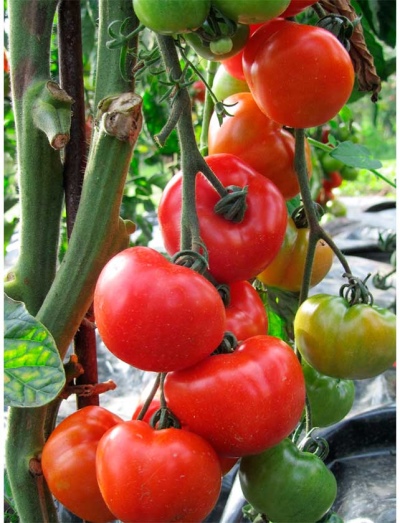
- Authors: Gavrish S.F., Kapustina R.N., Gladkov D.S., Volkov A.A., Semenova A.N., Artemyeva G.M., Filimonova Yu.A., Redichkina T.A.
- Year of approval: 2011
- Category: grade
- Growth type: determinant
- Appointment: fresh consumption, for canning in wedges, for juice
- Ripening period: mid-season
- Ripening time, days: 108-115
- Growing conditions: for open ground, for film greenhouses
- Bush size: undersized
- Bush height, cm: 80
The variety with the amazing name Pelageya was bred for cultivation in greenhouses or in open areas. The vegetable crop has received a high resistance to unfavorable weather conditions. And also the tomato is unpretentious in cultivation and will delight you with a stable harvest, while observing the minimum requirements of agricultural technology.
Description of the variety
In plastic greenhouses or in the open air, tomatoes will grow and bear fruit regularly. Growth type is determinant. Pelageya tomatoes are great for juicing, canning in slices or eating in their natural form. Low-growing bushes grow up to 80 centimeters. Leaves are of a standard shape, light green, with slight corrugation. The size is medium. The plant forms 3 to 4 stepchildren. The inflorescences are simple.
The main qualities of the fruit
Unripe light green fruits turn red. An orange tint is sometimes observed. The shape is flat, the ribbing is medium. Tomatoes weigh 200-250 grams. The size is large. The pulp is firm but juicy. When cut, there are 4 to 5 seed nests with a small number of grains.
Tomatoes are great for both processing and fresh consumption. After heat treatment, the amount of vitamins and nutrients in tomatoes does not decrease.
Taste characteristics
Ripe Pelageya tomatoes demonstrate excellent taste. The taste is rich sweet.
Ripening and fruiting
Vegetable culture is mid-season. The ripening time of the crop is from 108 to 115 days, depending on the climate and growing conditions. Harvested in summer from July to August.
Yield
Pelageya is considered a high-yielding variety. One bush bears from 4.5 to 6 kilograms of fruit, and more than 6 kilograms of vegetables are harvested from a square meter of the garden. Experienced gardeners get up to 7.5 kilograms from 1 m2 of land.
The timing of planting seedlings and planting in the ground
At the end of March or in early April, seeds are sown for seedlings. In late spring (May), young plants are transferred to a permanent cultivation site. To get strong and healthy seedlings, you need to prepare the seed and perform other actions. It is advisable to disinfect the seeds. A manganese solution is often used. If used containers are used for cultivation, it must be processed before re-cultivation.
The tomato needs sufficient lighting. Not only the growth of seedlings depends on light, but also their health. The soil for planting should include peat (at least 40%). And also the soil should be saturated with trace elements and mineral components. If garden soil is used for planting, it must be ignited and steamed.
Drainage material is placed at the bottom of the container to drain excess moisture. Fine charcoal mixed with soil will do. A gap of 3 centimeters is left between the grains. After planting the seed, the containers are transferred to a dry room with a high temperature (about 30 degrees Celsius). After 10 days, you can observe the first shoots.
Now you need to provide the sprouts with the required amount of light, and the temperature regime is lowered to +20 degrees. Once a week, the sprouts are fed with liquid fertilizers.Before transferring the seedlings to a new place, the seedlings are carefully examined. Weakened and deformed bushes are discarded.

Growing tomato seedlings is an extremely important process, because it largely depends on whether the gardener can harvest at all. All aspects must be taken into account, from seedbed preparation to planting in the ground.
Landing scheme
The optimal scheme for the Pelageya variety is 40x50 centimeters.

Growing and care
Taking care of the bushes is easy. The main thing is to comply with certain conditions that fruit crops need.
Recommendations from experienced gardeners.
The drip irrigation system is the best option for irrigating tomato plantations, however, the bushes tolerate overhead irrigation quite satisfactorily.
The beds are regularly loosened and cleaned of weeds and other debris.
To prevent moisture from evaporating quickly, the ground around the bushes is covered with mulch from crushed grass.
It is advisable to install the supports immediately after transplanting the bushes. Tie up the shoots carefully using soft twine and other options.
To obtain large tomatoes, the lower leaves are removed. And also thinning improves the aeration of the bushes.
Water the plants every 10 days.
Many gardeners use substances that accelerate the growth and ripening of fruits.
The bulk of the crop ripens in July, so you should keep as many ovaries as possible. Plants can be affected by intense sunlight and high temperatures during flowering. And also low humidity negatively affects the bushes. In a hot and dry season, the beds are specially shaded to protect them from sunburn. Gardening stores sell special nets that will not only protect the crop from the sun, but also from the attacks of the Colorado potato beetle.
After precipitation, it is advisable to treat the area with Bordeaux liquid.
Despite the formation of lateral processes, pinching is optional.




A plant needs different micronutrients at each stage of growth. All fertilizers can be divided into two groups: mineral and organic. Folk remedies are often used: iodine, yeast, bird droppings, eggshells.
It is important to observe the rate and period of feeding. This also applies to folk remedies and organic fertilizers.



























































































